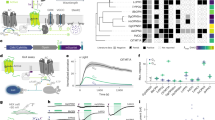Abstract
THEmodulation of voltage-dependent calcium channels by various neurotransmitters has been demonstrated in many neurons1–4. Because of the critical role of Ca2+ in transmitter release and, more generally, in transmembrane signalling, this modulation has important functional implications. Hippocampal neurons possess low-threshold (T-type) Ca2+ channels and both L- and N-type high voltage-activated Ca2+ channels.5–7N-type Ca2+ channels are blocked selectively by ω-conotoxin 8,9 and adenosine 10,11. These substances both block excitatory synaptic transmission in the hippocampus12–13, whereas dihydropyridines, which selectively block L-type channels14, are ineffective12. Excitatory synaptic transmission in the hippocampus displays a number of plasticity phenomena that are initiated by Ca2+ entry through ionic channels operated by N-methyl-D-aspartate (NMDA) receptors15,16. Here we report that NMDA receptor agonists selectively and effectively depress N-type Ca2+ channels which are involved in neurotransmit-ter release from presynaptic sites. The inhibitory effect is eliminated by the competitive NMDA antagonist D-2-amino-5-phosphonovalerate, does not require Ca2+ entry into the cell, and is probably receptor-mediated. This phenomenon may provide a negative feedback between the liberation of excitatory transmitter and entry of Ca2+ into the cell, and could be important in presynaptic inhibition and in the regulation of synaptic plasticity.
This is a preview of subscription content, access via your institution
Access options
Subscribe to this journal
Receive 51 print issues and online access
$199.00 per year
only $3.90 per issue
Buy this article
- Purchase on Springer Link
- Instant access to full article PDF
Prices may be subject to local taxes which are calculated during checkout
Similar content being viewed by others
References
Dunlap, K. & Fischbach, G. D. J. Physiol., Lond. 317, 519–535 (1981).
Deisz, R. A. & Lux, H. D. Neurosci. Lett. 56, 205–210 (1985).
Bean, B. P. Nature 340, 153–156 (1989).
Toselli, M., Lang, J., Costa, T. & Lux, H. D. Pflugers Arch. ges. Physiol. 415, 255–262 (1989).
Jones, O. T., Kunze, D. L. & Angelidis, K. J. Science 244, 1189–1193 (1989).
Ozawa, S., Tsuzuki, L., Iino, M., Ogura, A. & Kudo, Y. Brain Res. 495, 329–336 (1989).
Takahashi, K., Wakamori, M. & Akaike, N. Neurosci. Lett. 104, 229–234 (1989).
Kasai, H., Aosaki, T. & Fukuda, J. Neurosci. Res. 4, 228–235 (1987).
Plummer, M. R., Logothetis, D. E. & Hess, P. Neuron 2, 1453–1462 (1989).
Tsien, R. W., Lipscombe, D., Madison, D. V., Bley, K. R. & Fox, A. P. Trends Neurosci. 11, 431–438 (1988).
Gross, R. A., Macdonald, R. L. & Ryan-Jastrow, T. J. Physiol., Lond. 411, 585–595 (1989).
Kamiya, H., Sawada, S. & Yamamoto, C. Neurosci. Lett. 91, 84–88 (1988).
Krishtal, O. A., Petrov, A. V., Smirnov S. V. & Nowycky, M. C. Neurosci. Lett. 102, 197–204 (1989).
Fox, A. P., Nowycky, M. C. & Tsien, R. W. J. Physiol., Lond. 394, 149–172 (1987).
Sarvey, J. M., Burgard, E. C. & Decker, G. J. Neurosci. Meth. 28, 109–124 (1989).
Collingridge, G. L. & Bliss, T. V. P. Trends Neurosci. 10, 288–293 (1988).
Zorumski, C. F. & Yang, J. J. Neurosci. 8, 4277–4286 (1988).
Honoré, T., Lavridsen, J. & Kragsgaard-Larsen, P. J. Neurochem. 38, 173–178 (1982).
Krishtal, O. A., Smirnov, S. V. & Osipchuk, Yu. V. Neurosci. Lett. 85, 82–88 (1988).
Collingridge, G. L., Kehl, S. J. & McLennan, H. J. Physiol., Lond. 334, 33–46 (1983).
Bertolino, M. B., Vicini, S. & Costa, E. Neuropharmacology 28, 453–457 (1989).
Docherty, R. J. & Brown, D. A. Neurosci. Lett. 70, 110–115 (1986).
Gahwiler, B. H. & Brown, D. A. Neuroscience 20, 731–738 (1987).
Okada, Y. & Ozawa, S. Eur. J. Pharmac. 68, 483–492 (1980).
Chizmakov, I. V., Kiskin, N. I., Krishtal, O. A. & Tsyndrenko, A. Ya. Neurosci. Lett. 99, 131–136 (1989).
Krishtal, O. A., Marchenko, S. M. & Pidoplichko, V. I. Neurosci. Lett. 35, 41–45 (1983).
Author information
Authors and Affiliations
Rights and permissions
About this article
Cite this article
Chernevskaya, N., Obukhov, A. & Krishtal, O. NMDA receptor agonists selectively block N-type calcium channels in hippocampal neurons. Nature 349, 418–420 (1991). https://doi.org/10.1038/349418a0
Received:
Accepted:
Issue Date:
DOI: https://doi.org/10.1038/349418a0
This article is cited by
-
Glutamate-induced suppression of inhibitory synaptic transmission in cultivated hippocampal neurons
Neurophysiology (1998)
-
Neuronal and glial localization of NMDA receptors in the cerebral cortex
Molecular Neurobiology (1997)
-
Potentiation of voltage-dependent calcium channel currents by NMDA receptor agonists
Neurophysiology (1997)
-
Modulation of excitatory synaptic transmission by adenosine: Possibility of interaction with Ca-delivering machinery
Neurophysiology (1995)
-
Modulatory effects of diadenosine polyphosphates on different types of calcium channels in the rat central neurons
Neurophysiology (1994)
Comments
By submitting a comment you agree to abide by our Terms and Community Guidelines. If you find something abusive or that does not comply with our terms or guidelines please flag it as inappropriate.



